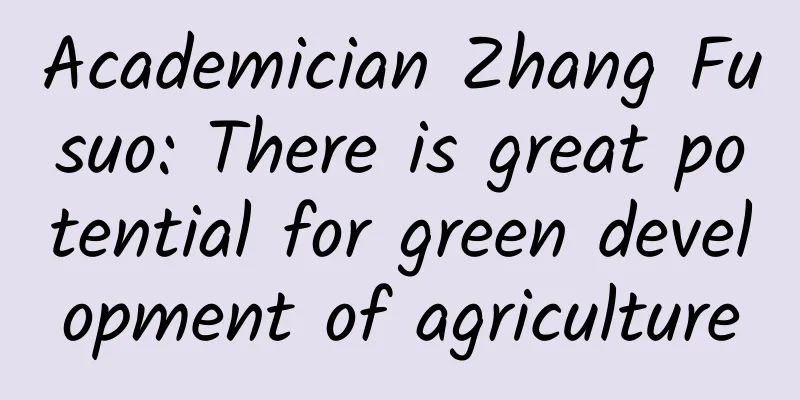Academician Zhang Fusuo: There is great potential for green development of agriculture

|
Editor's note: General Secretary Xi Jinping pointed out that "popularizing science is an important basic work for achieving innovative development." In order to help high-level scientific and technological self-reliance, the Science Popularization Department of the China Association for Science and Technology and Guangming Online jointly launched the "Academician High-end Science Popularization" column, inviting academicians from various fields to give authoritative answers to current hot scientific and technological issues in my country, serving to guide more scientific and technological workers to improve their scientific research and popularization capabilities, promote the improvement of the scientific literacy of the whole people, and contribute to the popularization of science for the construction of a strong country in science and technology. #千万IP创科普 Many people think that agriculture is naturally equivalent to green, but this is not the case. In recent years, my country's agricultural development has continuously stepped up to a new level. While grain has been harvested year after year, it has also paid a certain price. In order to meet human needs, agricultural production activities have greatly changed the natural state of the earth, such as cutting down forests to plant crops and raising livestock and poultry on a large scale. Although these activities provide abundant food and energy, they also generate a lot of waste. On the other hand, the agricultural system is not a closed system. In the production process, there will inevitably be problems such as "leakage of air, water, and fertilizer", which makes the agricultural ecological environment light up a "red light". If these issues are not properly handled, they will cause irreversible damage to the earth's ecosystem. Agriculture not only shoulders the responsibility of producing food and energy raw materials, but also needs to shoulder the mission of protecting the earth's environment. This also further shows that agriculture must transform towards green development. However, at present, my country's agriculture faces the challenges of high investment, insufficient output and high environmental cost. Take fertilizer as an example. Since 1985, it has been widely used. At its peak, the amount of chemical nitrogen fertilizer used was 1.5 times the actual demand of crops. The excessive surplus caused pollution risks. Therefore, the goal of green agricultural development is to increase production by more than 30%, increase efficiency by more than 50%, and reduce emissions by more than 50% on the existing basis. The quality should be greatly improved, farmers' income should be greatly increased, and the service function of the ecosystem should be greatly improved. Only when these goals are achieved can we truly achieve green agricultural development. To achieve this goal, we propose a "three-step" strategy: the first step is to reduce fertilizer and increase efficiency, that is, to ensure that the output does not decrease or increase slightly without increasing input, and save more than 20% of fertilizer; the second step is to increase production and efficiency in a green way, to achieve an increase of 10%-20% in production and an increase of 30% in efficiency; the third step is to achieve green high-yield and high-efficiency, to increase production by 30%, reduce emissions and increase efficiency by 50%. If this can be achieved, my country will become a model for green development of global agriculture. As far as crop production is concerned, we have been exploring the first step strategy since the beginning of this century. In the soil testing and formula fertilization action, Mr. Zhu Zhaoliang and I conducted rotation experiments on wheat and corn, wheat and rice in North China and the Taihu Lake Basin. We found that we could reduce nitrogen fertilizer input by 30%, but the yield would not decrease, the efficiency could be increased by 30%-50%, and environmental emissions (including atmospheric, water and soil residues, etc.) could also be reduced exponentially. In the second step of the strategy, we first made a breakthrough in corn. Through practice in North China and Northeast China, we found that on the basis of achieving the first step, a green yield-increasing and efficiency-enhancing technology system with soil-crop system integrated management as the core was established, which achieved high crop yields and high resource efficiency. Later, we applied this technology to the three major grain crop producing areas in the country, with an average yield increase of 30% and emission reduction of 50%. The relevant results were published in Nature in 2014. The third step is relatively more difficult to achieve. The reason is that the quality of arable land in my country cannot meet the requirements. Without fertilization, 50% of water and nutrients need to be supplied to meet the needs of crop growth, while Europe and the United States only need 20% to 30%. In order to improve the quality of arable land, it is necessary to optimize the management of the tillage layer, regulate the plant population to the best state of matching light and heat, realize the maximum conversion of light and temperature resources into dry matter, and integrate the green, high-yield and high-efficiency technology model of fertile soil-root layer regulation-population optimization. In addition, mechanization and informatization are also needed. Take Quzhou, Hebei Province as an example. In 1973, the older generation of teachers and students of China Agricultural University, represented by Shi Yuanchun and Xin Dehui, took root here and launched a scientific and technological campaign of "improving soil and treating alkali". The results were quickly promoted throughout the country, involving 380 million people and 470 million low-yield farmlands. The "Research on Comprehensive Agricultural Development in the Huanghuaihai Region" also won the National Science and Technology Progress Special Award. In 2009, our team of teachers and students established the first science and technology courtyard in the country in Quzhou, and worked with farmers to carry out technical innovation and application promotion of high-yield and high-efficiency crops and green yield and efficiency increase. By 2024, the annual per-acre yield of Quzhou's green grain increase "Thousand-acre Demonstration Square" will reach 1,522 kg, achieving a major breakthrough in "green tons and a half of grain". Over the past 51 years, Quzhou, Hebei Province has experienced a transformation from improving soil and treating alkali to high yield and high efficiency, and then to green, high-quality and high-efficiency. The former saline-alkali beach has become a rice-producing river. Today, science and technology courtyards, as the forefront of technological innovation and application, have spread across more than 1,800 locations across the country, benefiting 570 million mu of land and 20 million farmers, demonstrating the huge potential of science and technology in promoting the green development of agriculture. However, we should also see that although the green development of agriculture has been widely carried out across the country, the public's participation and action are still insufficient. It is urgent to deepen the understanding of the necessity of green development from the conceptual level and guide the public to pay attention to green development from the policy level. The responsibility of protecting the environment cannot be pushed entirely to farmers. For agricultural product consumers, they also have the responsibility to promote and apply the concept of green development, especially urban consumers, who have the knowledge and ability to promote green and healthy consumption. They should work together to protect the earth, develop green agriculture, and build a green home. Looking to the future, I know that technological progress will never end. From traditional water and fertilizer management and cultivation technology to modern breeding of improved varieties, development of green inputs, and integrated application of good methods and intelligent equipment, each step of progress provides the possibility for realizing the green transformation of agriculture. I firmly believe that by continuously tapping the potential of soil and ecological environment and combining the power of intelligent technology, the green development of agriculture will not only have great potential, but will also become an important force in promoting the country's sustainable development strategy. (Author: Zhang Fusuo, academician of the Chinese Academy of Engineering, professor of China Agricultural University, compiled by Guangming Online reporters Cai Lin and Li Xinzhe) |
<<: What efforts have people made in pursuit of "sweetness"?
Recommend
Luo Yonghao's Hammer: The low-end model with no physical buttons is only 899 yuan
[[143983]] It was previously reported that the Sm...
How much does a set of 2022 Asian Games commemorative coins cost? How to make an appointment? Reservation entrance attached!
In April 2022, the central bank issued an announce...
WeChat data structure
@Fenng from "Gossip" posted three inter...
Top 10 GitHub open source iOS libraries to speed up app development
【51CTO.com Quick Translation】iOS is one of the mo...
Fission Guide: What is traffic pool thinking?
The core idea of " traffic pool thinking&q...
Movies adapted from games = bad movies? Deep thoughts on movies adapted from games
In recent years, China has introduced a large num...
Why isn’t your Tik Tok recommended? A guide to avoiding pitfalls on Tik Tok!
Three quarters of 2018 have passed in the blink o...
Top 10 New Media Moments of 2016
In 2016, the new media industry is still hot. Som...
Product activity operation and promotion planning plan!
Activities are a very important way to quickly at...
Is there a sure-fire way to win at mahjong? Which game is more complicated: chess, go, mahjong, or Texas Hold'em?
Many children like board games, such as chess, go...
360 Cloud Disk is retired and other survivors will play the Hunger Games
"Winter is here, can spring be far behind?&q...
my country's first Mars exploration mission achieves rich scientific results
According to the National Space Administration on...
Don't set your alarm like this! It can cause more harm than you think...
"Ding-ling, ding-ding~~~" How many alar...
A complete Douyin short video promotion plan, take it for reference~
A very complete Douyin short video promotion plan...
How to activate a “professional account” on Xiaohongshu? Here is a guide for you to start
Today, Xiaohongshu adjusted its account system an...









